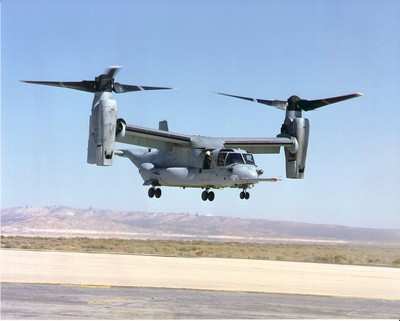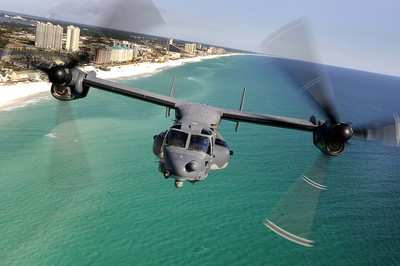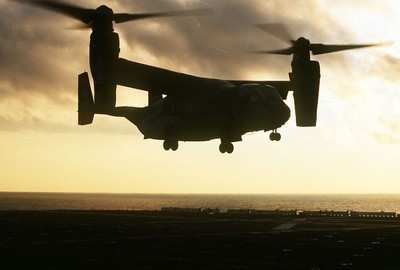Board Could Not Determine Cause By "Clear And Convincing
Evidence" Standard
Air Force Special Operations Command officials released the
results of their investigation into the CV-22 Osprey accident April
9, near Qalat, Afghanistan late last week. Four were killed and 16
injured in the accident.

CV-22 File Photo
The pilot, flight engineer, an Army Ranger, and a civilian
contract employee were killed in the crash.
Under the authority delegated to him by the AFSOC commander, the
AFSOC vice-commander convened an Accident Investigation Board to
investigate the matter, and designated Brig. Gen. Donald Harvel,
the Air National Guard assistant to the commander, AFSOC, Hurlburt
Field, FL, as the board president.
Concluding the investigation, the board president could not
determine the cause of the mishap by the standard of "clear and
convincing evidence," in part because the flight incident recorder,
the Vibration Structural Life and Engine Diagnostics control unit,
and the right engine were destroyed and therefore not available for
analysis. After an exhaustive investigation of the available
evidence, the board president ruled out multiple possible causes.
Items ruled out included loss due to enemy action, environmental
brownout conditions and vortex ring state. In addition, a design
problem that led to the replacement of the Central De-ice
Distributor support bracket found in all Marine Corps and Air Force
Ospreys, was not a factor.

CV-22 File Photo
The board president determined 10 factors substantially
contributed to the mishap. These included inadequate weather
planning, a poorly executed, low-visibility approach, a tailwind, a
challenging visual environment, the mishap crew's task saturation,
the mishap copilot's distraction, the mishap copilot's negative
transfer of a behavior learned in a previous aircraft, the mishap
crew's pressing to accomplish their first combat mission of the
deployment, an unanticipated high rate of descent and engine power
loss. Substantially contributing factors play an important role in
the mishap sequence of events and are supported by the greater
weight of credible evidence.
The convening authority approved the board president's report,
with comments. While legally sufficient, he assessed the evidence
in the AIB report did not support a determination of engine power
loss as one of the 10 substantially contributing factors. The
convening authority made this decision based upon the evidence in
the AIB report and additional analysis of the evidence in the
report. The convening authority concluded the preponderance of
credible evidence did not indicate engine power loss as a
substantially contributing factor of the mishap.
After a review of the original AIB report, the convening
authority's statement of opinion and additional material obtained
after the completion of the AIB report, the chief of staff of the
Air Force reopened the investigation and directed the AIB board
president to analyze the additional information.

CV-22 File Photo
The board president conducted a follow-on investigation to
analyze two Naval Air Systems Command reports and the convening
authority's analysis of video data. After consideration of the new
material the only fact the AIB president changed from his original
report was the ground speed of the aircraft at impact from what was
believed to be 75 knots to 80 knots at the time of impact. The
remainder of the findings was unchanged.
 Classic Aero-TV: The Switchblade Flying Car FLIES!
Classic Aero-TV: The Switchblade Flying Car FLIES! ANN FAQ: Q&A 101
ANN FAQ: Q&A 101 ANN's Daily Aero-Term (04.12.24): Discrete Code
ANN's Daily Aero-Term (04.12.24): Discrete Code ANN's Daily Aero-Term (04.13.24): Beyond Visual Line Of Sight (BVLOS)
ANN's Daily Aero-Term (04.13.24): Beyond Visual Line Of Sight (BVLOS) ANN's Daily Aero-Linx (04.13.24)
ANN's Daily Aero-Linx (04.13.24)





